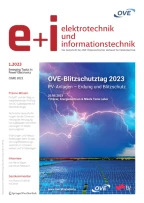Zusammenfassung
Die Energiewende bewirkt eine Transformation des Energiesystems, die zu großen Herausforderungen für den Verteilernetzbetrieb führt. Dies ist der Tatsache geschuldet, dass bis dato passive Verteilernetz-Abschnitte, welche historisch reine Verbraucher waren, nunmehr durch dort verortete dezentrale Erzeugung und proaktive Netzteilnehmer – wie Photovoltaikanlage, Speicher und E-Mobility – aktiv Einfluss auf den Netzbetrieb nehmen. Durch die Integration und den Einsatz intelligenter Automatisierung sollen diese Netzabschnitte in Zukunft aktiv gesteuert werden. Das daraus resultierende Gesamtsystem stellt ein cyber-physikalisches System dar, dass durch einen hohen Komplexitätsgrad gekennzeichnet ist und die elektrische und algorithmische Welt mittels geeigneter IKT-Infrastruktur koppelt. Es ist davon auszugehen, dass die Steuerung und Automatisierung in solchen Systemen immer individueller wird. Dafür bedarf es flexibler und (hinsichtlich Installation und Wartung) einfach zu bedienender Automatisierungssysteme, die es den Betreibern von Verteilernetzen erlauben, individualisierte Lösungen nahtlos in ihren Netzen zu integrieren. Dieser Beitrag beschreibt einen Systemansatz, der aufbauend auf einer Industrial Internet-of-Things(IoT)-Plattform die Interaktion der notwendigen physikalischen Modelle und Anwendungen realisiert und somit zur Lösung dieser Herausforderungen eingesetzt werden kann.
Abstract
Currently an increased integration of distributed energy resources and prosumers into the distribution system can be observed. These new resources range from renewable energy resources such as PV-systems, to storage systems, and e-mobility charging stations. This trend is coined under the term “Energiewende” and presents a challenge for the system operators, as the grid-level (where the integration of these entities happens) was initially designed for distribution purposes only and was thus operated passively. In order to mitigate and solve resulting problems, intelligent automation systems can be used to actively operate these grids. The resulting system constitutes a cyber physical system, which is characterized by a high degree of complexity and connects the electrical and the algorithmic world, using a suitable ICT infrastructure. As the control and automatization of such systems becomes more and more individual, flexible and simple to use (regarding installation and maintenance) automation systems are required, which allow the operator the seamless integration of individualized solutions into their grids. This article describes a system approach that is based on industrial Internet-of-Things technology and allows realizing the required interaction between the physical models and applications; thus presenting a solution to solve these challenges.
Literatur
Kühne, O., Weber, F. (2018): Bausteine der Energiewende – Einführung, Übersicht und Ausblick. In Bausteine der Energiewende (S. 3–19). Wiesbaden: Springer.
Karnouskos, S. (2011): Cyber-physical systems in the SmartGrid. In 2011 9th IEEE international conference on industrial informatics, INDIN.
Cejka, S., Hanzlik, A., Plank, A. (2016): A framework for communication and provisioning in an intelligent secondary substation. In 2016 21st IEEE international conference on emerging technologies and factory automation, ETFA.
Faschang, M., Cejka, S., Stefan, M., Frischenschlager, A., Einfalt, A., Diwold, K., Pröstl Andrén, F., Strasser, T., Kupzog, F. (2017): Provisioning, deployment, and operation of smart grid applications on substation level. Comput. Sci. Res. Dev., 32(1), 117–130.
Einfalt, A., Cejka, S., Diwold, K., Frischenschlager, A., Faschang, M., Stefan, M., Kupzog, F. (2017): Interaction of smart grid applications supporting plug & automate for intelligent secondary substations. CIRED, Open Access Proc. J., 2017(1), 1257–1260.
Baran, P. (1964): On distributed communications networks. IEEE Trans. Commun. Syst., 12(1), 1–9.
VDI/VDE – Gesellschaft für Mess- und Automatisierungstechnik (Hrsg.) (2013): Cyber-Physical Systems: Chancen und Nutzen aus Sicht der Automation. Berlin: VDI/VDE.
Prostejovsky, A., Merdan, M., Andren, F., Strasser, T. (2012): MASGrid: a Multi-Agent-based Smart Grid control approach. Talk: Dritte Fachkonferenz Kommunikation für Energienetze der Zukunft – Smart Grids werden Realität! ComForEn 2012, Wels, 2012-09-05. OVE-Schriftenreihe (Bd. 65, S. 90–96). OVE – Österreichischer Verband für Elektrotechnik/Austrian Electrotechnical Association, Wien. ISBN: 978-3-85133-072-4.
Faschang, M., Xypolytou, E., Meisel, M., Wendt, A., Kaufmann, T., Litzlbauer, M., Marchgraber, J., Bibl, M., Prostejovsky, A., Gawron-Deutsch, T., Kienesberger, G. (2015): Transition roadmap—from centralized to massively decentralized grid control systems, Nov. 2014. In Dipl.-Ing., Bakk. techn. Marcus Meisel (Hrsg.), Wissenschaftlicher Bericht für die FFG. Eigenverlag des Institut für Computertechnik der TU Wien, Energy&IT Group, Wien. 75 S., ISBN: 978-3-200-04337-4.
Hauck, S., DeHon, A. (2010): Reconfigurable computing: the theory and practice of FPGA-based computation (Bd. 1). Amsterdam: Elsevier.
Schuster, T. (2014): Auswirkungen der unsymmetrischen Belastung im Niederspannungsnetz für dezentrale Energieeinspeiser. In Tagungsunterlagen Eninnov 2014, Graz.
Nadareishvili, I., Mitra, R., McLarty, M., Amundsen, M. (2016): Microservice architecture: aligning principles, practices, and culture. Sebastopol: O’Reilly Media, Inc.
Fielding, R. (2000): Architectural styles and the design of network-based software architectures. Dissertation.
Surwase, V. (2016): REST API modeling languages—a developer’s perspective. Int. J. Sci. Technol. Eng., 2(10), 634–637.
Danksagung
Das Projekt iNIS wird aus Mitteln des FFG-Forschungsprogramms IKT der Zukunft (2. Call) unter der Nummer (849902) gefördert, und der Proof of Concept wird im Testbed der ASCR in Aspern durchgeführt.
Author information
Authors and Affiliations
Corresponding author
Rights and permissions
About this article
Cite this article
Gawron-Deutsch, T., Diwold, K., Cejka, S. et al. Industrial IoT für Smart Grid-Anwendungen im Feld. Elektrotech. Inftech. 135, 256–263 (2018). https://doi.org/10.1007/s00502-018-0617-4
Received:
Accepted:
Published:
Issue Date:
DOI: https://doi.org/10.1007/s00502-018-0617-4
